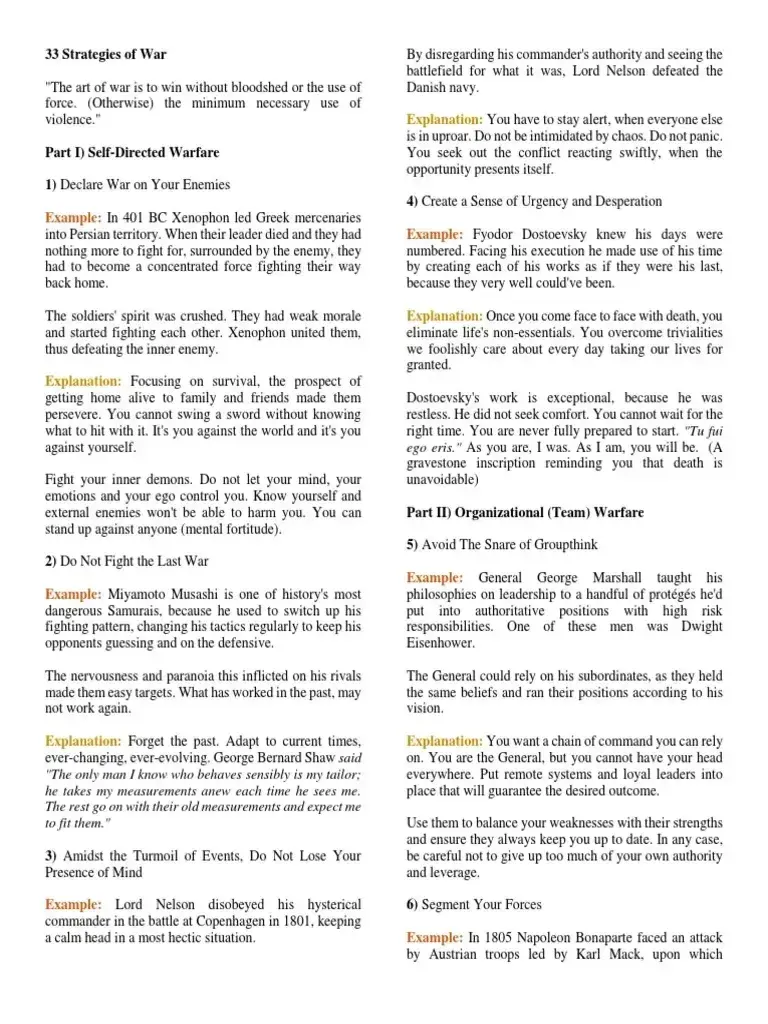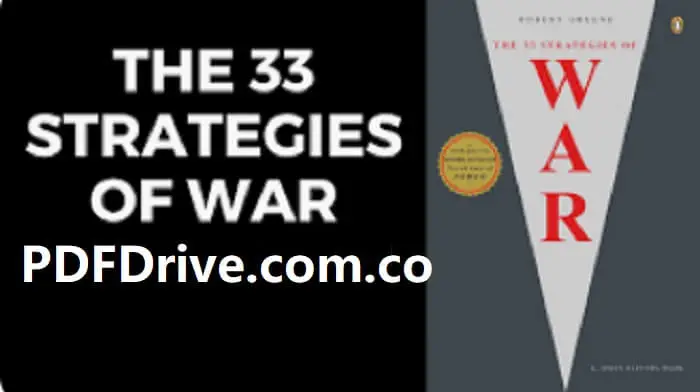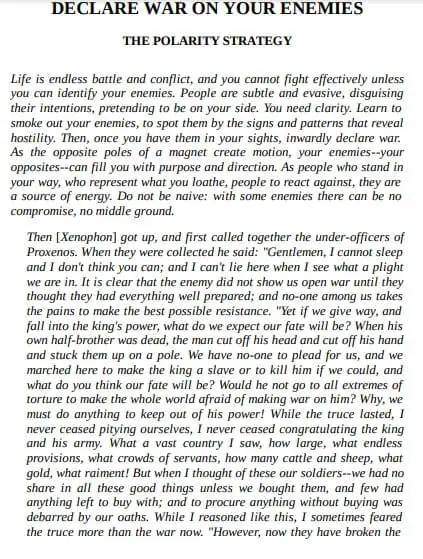Learn the 33 ancient strategies of war and apply them to your modern-day life. This book summary will teach you how to win in business, relationships, and personal development.
| Name of PDF | The 33 Strategies of War |
|---|---|
| No Pages | 701 |
| Author | Robert Greene |
| Originally Published | January 2006 |
| Language | English |
| Genres | Self-help, Personal development |
| Size | 3.02 MB |
| Chek the latest edition |
More self-help The Daily Laws PDF

Table of Contents
Introduction to The 33 Strategies of War PDF
The 33 Strategies of War PDF is a book by Robert Greene that draws on military history, business management, and psychology to provide readers with a guide to winning in all aspects of life. The book is divided into 33 chapters, each of which focuses on a different strategy for success.
Greene’s strategies are not always ethical or moral, but they are effective. He teaches readers how to use deception, manipulation, and aggression to their advantage. He also shows readers how to identify and exploit their enemies’ weaknesses.
The 33 Strategies of War PDF is a controversial book, but it is also a popular one. It has been praised by many for its insights into human nature and its practical advice on how to succeed in life.
What is The 33 Strategies of War PDF?
The 33 Strategies of War PDF is a book that provides readers with a guide to winning in all aspects of life. It is written by Robert Greene, who is also the author of the best-selling books The 48 Laws of Power and The Art of Seduction.
The book is divided into 33 chapters, each of which focuses on a different strategy for success. Greene’s strategies are based on his study of military history, business management, and psychology.
The 33 Strategies of War PDF: A Summary
The 33 Strategies of War PDF is a book that provides readers with a guide to winning in all aspects of life. It is written by Robert Greene, who is also the author of the best-selling books The 48 Laws of Power and The Art of Seduction.
The book is divided into 33 chapters, each of which focuses on a different strategy for success. Greene’s strategies are based on his study of military history, business management, and psychology.
Here is a brief summary of some of the key strategies from the book:
- Know yourself and your enemy.
- Attack the enemy’s weak points.
- Divide and conquer.
- Use deception.
- Be unpredictable.
- Create an aura of invincibility.
- Use your allies wisely.
- Know when to quit.
The 33 Strategies of War PDF: How to Apply the Strategies to Your Life
The 33 Strategies of War PDF can be applied to all aspects of life, including business, relationships, and personal development.
Here are some tips for applying the strategies to your life:
- Choose the right strategies for the situation. Not all of the strategies in the book are appropriate for every situation. It is important to choose the strategies that are most likely to help you achieve your goals.
- Be aware of the risks. Some of the strategies in the book can be dangerous if used incorrectly. It is important to be aware of the risks before using any of the strategies.
- Be ethical. It is important to use the strategies in the book in an ethical way. Do not use the strategies to harm others.

The 33 Strategies of War PDF: Pros and Cons
Pros:
- The book provides readers with a wide range of strategies for success.
- The strategies are based on Greene’s study of military history, business management, and psychology.
- The book is well-written and easy to read.
Cons:
- Some of the strategies in the book are unethical or immoral.
- The book does not provide enough guidance on how to choose the right strategies for the situation.
- The book does not adequately address the risks associated with using some of the strategies.
The 33 Strategies of War PDF: Strategy #1: Know Yourself and Your Enemy
The first strategy in The 33 Strategies of War PDF is to know yourself and your enemy. This means understanding your own strengths and weaknesses, as well as the strengths and weaknesses of your opponent.
To know yourself, you need to be honest with yourself about your abilities and limitations. You also need to be aware of your emotions and how they affect your behavior.
To know your enemy, you need to research them carefully. You need to understand their goals, their strengths and weaknesses, and their motivations.
Once you know yourself and your enemy, you can start to develop a strategy for defeating them.
View other drafts
The 33 Strategies of War PDF: Strategy #2: Attack the Enemy’s Weak Points
One of the most important strategies in The 33 Strategies of War PDF is to attack the enemy’s weak points. This means identifying and exploiting the enemy’s vulnerabilities.
There are many different ways to attack an enemy’s weak points. For example, you could:
- Attack the enemy’s weakest physical points. This could include attacking their flanks, their rear, or their supply lines.
- Attack the enemy’s weakest emotional points. This could include exploiting their fears, their insecurities, or their internal divisions.
- Attack the enemy’s weakest intellectual points. This could include exploiting their mistakes, their biases, or their lack of knowledge.
The key is to identify the enemy’s weak points and then attack them with everything you have.
Here are some examples of how to attack the enemy’s weak points in different situations:
- In a business negotiation, you could attack the other party’s weak points by pointing out their lack of experience, their financial difficulties, or their need to close the deal quickly.
- In a political campaign, you could attack your opponent’s weak points by pointing out their voting record, their personal scandals, or their lack of qualifications.
- In a military conflict, you could attack your enemy’s weak points by targeting their supply lines, their vulnerable infrastructure, or their demoralized troops.

The 33 Strategies of War PDF: Strategy #3: Divide and Conquer
Another important strategy in The 33 Strategies of War PDF is to divide and conquer. This means breaking down a large enemy into smaller, more manageable pieces.
There are many different ways to divide and conquer. For example, you could:
- Sow discord among the enemy’s ranks. This could involve exploiting their internal divisions, or creating new divisions.
- Attack the enemy’s weakest links. This could involve targeting their most vulnerable allies, or their most important supply lines.
- Isolate the enemy from their allies. This could involve surrounding them, or cutting off their lines of communication.
The key is to divide the enemy into smaller, more manageable pieces, and then defeat them one by one.
Here are some examples of how to divide and conquer in different situations:
- In a business negotiation, you could divide and conquer by playing two different parties against each other. You could also try to isolate one party from the other.
- In a political campaign, you could divide and conquer by targeting different groups of voters. You could also try to turn one group of voters against another.
- In a military conflict, you could divide and conquer by surrounding the enemy, or by cutting off their lines of communication. You could also try to create internal divisions among the enemy’s forces.
The 33 Strategies of War PDF: Strategy #4: Use Deception
Another important strategy in The 33 Strategies of War PDF is to use deception. This means misleading and confusing the enemy.
There are many different ways to use deception. For example, you could:
- Spread false information. This could involve planting rumors, or creating fake documents.
- Disguise your intentions. This could involve pretending to be someone you’re not, or making fake attacks.
- Create the illusion of strength. This could involve exaggerating your numbers, or making your forces appear more powerful than they are.
The key is to mislead and confuse the enemy so that they cannot predict your next move.
Here are some examples of how to use deception in different situations:
- In a business negotiation, you could use deception by pretending to be less interested in the deal than you really are. You could also spread false information about your negotiating position.
- In a political campaign, you could use deception by attacking your opponent with false accusations. You could also create fake polls or endorsements.
- In a military conflict, you could use deception by launching surprise attacks or using camouflage. You could also spread false information about your troop movements or your plans for battle.
The 33 Strategies of War PDF: Strategy #5: Be Unpredictable
One of the most important strategies in The 33 Strategies of War PDF is to be unpredictable. This means keeping the enemy guessing about your next move.
There are many different ways to be unpredictable. For example, you could:
- Change your plans often. This could involve switching between different strategies, or targeting different targets.
- Vary your tactics. This could involve using different methods of attack, or changing your timing.
- Be creative and innovative. This could involve developing new strategies or tactics, or using existing strategies and tactics in new and unexpected ways.
The key is to keep the enemy off balance and guessing about your next move. This will make it difficult for them to counter your attacks and achieve their own goals.
Here are some examples of how to be unpredictable in different situations:
- In a business negotiation, you could be unpredictable by changing your negotiating position often. You could also make surprise offers or demands.
- In a political campaign, you could be unpredictable by changing your campaign strategy frequently. You could also make surprise endorsements or announcements.
- In a military conflict, you could be unpredictable by launching surprise attacks or using camouflage. You could also change your troop movements frequently.

Conclusion
The 33 Strategies of War PDF is a book that provides readers with a wide range of strategies for success. The strategies can be applied to all aspects of life, including business, relationships, and personal development.
The five strategies that we have covered in this blog post are just a few of the many strategies that are included in the book. If you are interested in learning more about the 33 strategies, you can purchase the book or find more information online.
FAQs
Is The 33 Strategies of War PDF a good book?
Yes, The 33 Strategies of War PDF is a good book. It is well-written and easy to read. The strategies are based on Greene’s study of military history, business management, and psychology.
Can I apply the strategies in The 33 Strategies of War PDF to my life?
Yes, you can apply the strategies in The 33 Strategies of War PDF to your life. The strategies can be applied to all aspects of life, including business, relationships, and personal development.
What are some of the risks of using the strategies in The 33 Strategies of War PDF?
Some of the strategies in The 33 Strategies of War PDF can be dangerous if used incorrectly. It is important to be aware of the risks before using any of the strategies. It is also important to use the strategies in an ethical way.
Should I read 33 strategies of war?
it would be worth reading, informative and quite enjoyable.
What are the key points in The 33 Strategies of War?
Robert Greene The 33 Strategies of War Book Summary
Declare War on Your Enemies. …
Do Not Fight the Last War. …
Amidst the Turmoil of Events, Do Not Lose Your Presence of Mind. …
Create a Sense of Urgency and Desperation. …
Avoid The Snare of Groupthink. …
Segment Your Forces. …
Transform Your War into a Crusade.





